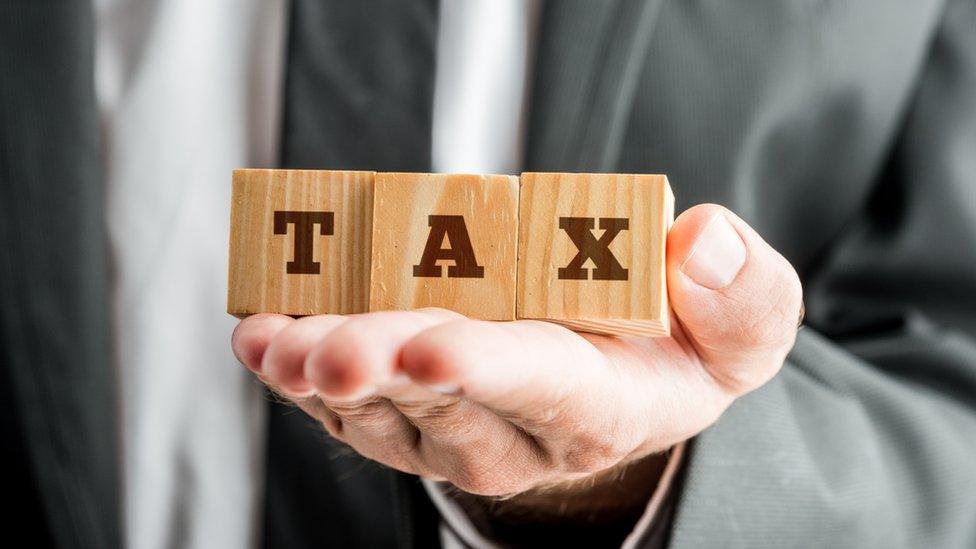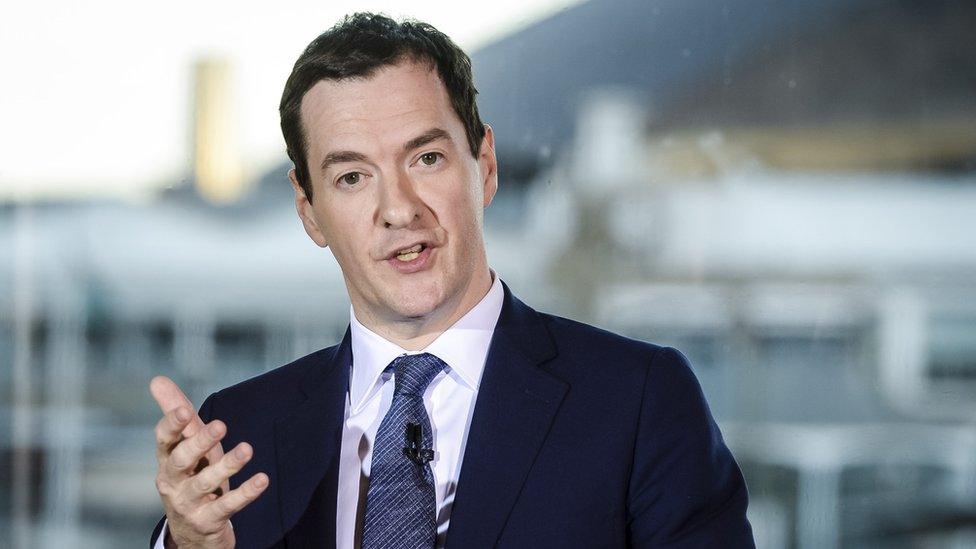Holyrood's tax choices
- Published

Consider it a menu of choices. But be warned: it's not a very appetising one.
The Institute of Public Policy Research (IPPR) has provided a very useful guide to the tax questions so far dominating the Holyrood election campaign, and one that takes us beyond the yah-boo rhetoric.
The newly-opened Scottish branch of this left-leaning think tank has crunched the numbers, using an income survey of 6,000 Scottish homes, the Family Resources Survey.
It gives the manifesto writers - and us voters - what it calls a "£2bn challenge".
That is: they are setting out the choices of how to use a significant boost to taxation and welfare powers, expected to reach Holyrood for the 2017-18 fiscal year.
Not significant enough, say nationalists and - in another new report just out - Reform Scotland. It says the high emphasis on income tax powers make the package of reforms too blunt an instrument to have the desired effects.
Corporation tax, national insurance and more of the welfare system need to be devolved, argues Reform Scotland. That would begin to look like the "devo max" idea, which would hand all tax powers to Holyrood, from which it would pay Westminster for shared services.

George Osborne may have to make more spending cuts to get the economy back into surplus
IPPR Scotland is not arguing over more powers. It is looking at the ones already heading in Holyrood's directions.
The biggest part of that £2bn funding question is what politicians plan to do about the £1.2bn cut in the spending plans for Scotland's devolved powers.
That's the likely effect of current Westminster plans for devolved powers, unless Holyrood makes changes.
With the economy faltering, tax take is likely to fall short of previous expectation. And with the Chancellor, George Osborne, wanting to get the budget into surplus by 2020, there could be a bigger spending cut on the way. We'll know more with his 2016 Budget on 16 March.
Either way, the claims of being able to counter austerity come at quite a cost.
Softening the blow
Likewise, Westminster changes to the welfare system are expected to take around £600m out of Scottish household incomes, much of it masked by the introduction of Universal Benefit.
IPPR Scotland says that 700,000 Scottish households will lose out by an average of £730.
So what are the next Holyroodful of MSPs going to do to soften that blow? Finding the cash to see off the impact of the bedroom tax (spare room subsidy) was a start, but how much further can the next Scottish government afford to go?
Ministers could counter the cuts to levels of in-work benefits. Keeping that at current levels would cost £300m, calculates the IPPR.
The Department of Work and Pensions is more sharply tapering away entitlement to benefits as the Universal Credit is introduced. In other words, as you move up the income scale, benefit entitlements fall away at an earlier point than has been the case.
To avoid that happening, and to keep things the way they have been, MSPs would have to find another £300m.
There's a case for increasing disability benefits in line with earnings rather than inflation. That carries a £100m annual price tag by 2020.

The smallest tranche of this set of challenges is in a change being planned at Westminster at the higher rate of tax. Conservative ministers want to do more for higher earners than they achieved in the past six years.
The threshold for paying higher rate tax has been held back, and as incomes have risen, more people have drifted into that 40% net. Under the previous Labour government as well, the Exchequer benefited from this "fiscal drift".
From next month, the threshold will be £43,000. By the 2017-18 fiscal year, when Holyrood gets its main bundle of new tax powers, that will likely be raised to £43,600.
At the Treasury, George Osborne then wants that threshold to rise to £50,000 by the 2020 election. But he has not said how fast that rise would take place. We may hear more in his Budget this month. But it costs him money to reduce tax that way.
He, could, meanwhile, confuse things further by taking a lesson from the Scottish Conservative tax commission, which recently suggested an intermediate band of tax - for instance, taxing the £30,000 to £50,000 range at perhaps 30%.
Tackling inequality
So what will Holyrood do in response to Westminster raising the threshold to £50,000? It will have control over that threshold of higher tax, so it will have to do something, even if it is to choose to follow the Tory agenda.
It could decide that higher rate tax payers should pay more. There's been a lot of talk of tackling inequality, and taking a different approach to higher rate tax would be one way of doing so.
That could be by retaining the lower level of threshold below Westminster's level, or by raising the 40% rate.
IPPR Scotland reckons that raising the threshold in line with Tory plans would leave Holyrood short by £300m. Keeping it at £43,600 would raise £300m, as people move into that income bracket.
So, of course, Holyrood's finance minister could set the threshold at a point in between - estimates of inflation would push it up to at least £46,100, for instance - and have a broadly neutral effect on revenue.

Apart from raising the threshold, what about raising the rate of tax on earnings over the £43,600 level?
The calculation here is that a 1p increase, to 41%, would affect 400,000 taxpayers in Scotland and cost them, on average, £300.
And whereas a 1p increase on basic rate tax could raise about £400m, targeting it only at higher rate taxpayers would raise £100m.
Then, there are the super-earners, on more than £150,000. On that income, you pay additional rate tax of 45%, under Westminster tax rules. Holyrood could choose to lower that threshold or to raise the percentage rate, or both.
The IPPR Scotland report does not have a reliable set of figures for the impact of that. Because only 17,000 Scots fall into that top earning category, the Family Resources Survey does not reach enough of them.
The guess is that a reduction in the threshold for paying the highest rate of tax were to drop £10,000, to £140,000, that could raise less than £10m. In other words, not much.


A menu of tax options
Reversing Westminster spending cuts: -£1.2 billion
Reversing Westminster welfare cuts: -£600m
Increasing threshold for higher rate from £43,600 to £50,000: -£300m
Increase basic rate from 20% to 21%: +£400m.
An average £220 extra would be paid by 1.6m households.
Increase higher rate tax from 40% to 41%: +£100m.
An average £300 would be paid by 400,000 households.
Lower the starting rate for top rate tax from £150,000 to £140,000: +£8.5m
Source: IPPR Scotland

Any change in income tax is likely to alter people's behaviour - how many hours they work, for instance, and to some extent, how, when or where they declare their earnings.
The impact is all the greater at higher levels of income, at which people are relatively mobile, and they can pay for the smartest accountants. So it is particularly unclear what behavioural impact a change in additional rate tax would have.
This behavioural effect could mean that higher tax rates actually lower tax take, and vice versa. The IPPR Scotland model has not taken that into account.
Given the porous border between Scotland and the rest of the UK - in people, finance and goods - it's very hard to guess how big the impact will be of a cross-border tax differential.
It is not just that higher rate taxpayers can move earnings south of the border and beyond to avoid higher rates in Scotland (or vice versa, should MSPs choose to make Scotland a low-tax haven): it is also that the new income tax powers do not capture earnings from savings and dividends.
So, for smallish businesses that pay their tax through the income tax system - and there are a lot of them, including the self-employed - their owners can choose to shift at least some of their earnings from income (taxable in Scotland) to dividends (taxable at a UK level, and potentially at a lower rate).
And another thing: this is not just a question of whether higher taxes push high earners and their earnings out of the Scottish tax jurisdiction. Higher tax also sends signals to potential incomers, such as inward investors, who are thinking of bringing business to Scotland. How big an effect? No-one knows.
'No detriment'
A further interesting question thrown up by IPPR Scotland: it points out that the one income threshold that will continue to be controlled from Westminster is the starting rate for income tax.
This year, that is at £10,600. The Tory manifesto last year promised to raise that to £12,500 by 2020.
If it does so, it will cut back the tax take for the Scottish finance department by around £300m.
That is a detriment to the Scottish budget. And the Smith Commission on devolution agreed there should be "no detriment" from a decision taken in one parliament that impacts on the finances available to the other. So would that £300m be paid as compensation?
And returning to today's other report, from Reform Scotland, it is a reminder that national insurance is a fiscal lever that remains firmly controlled at Westminster.
If the intention of policy on either side of the border is to reduce payroll taxes, to help the lower-paid, and to encourage job creation, then there is a diminishing return from raising the starting threshold for income tax.
Instead, there is a strengthening case for cutting back national insurance contributions. If there is to be "no detriment", and a likely impact on welfare calculations, doing so could be messy in devolution terms.
Passive to active
These figures are only indications of the kind of options facing politicians and the electorate at May's election. But they point towards options that cannot be ducked.
Sticking with Westminster tax rates is a choice to be made actively rather than tolerated passively.
What these choices miss, only briefly mentioned by IPPR Scotland, is that variations to tax and spending are not the only options open to Holyrood.
There are some measures that can be made to change the rate of economic growth - increasing the size of the pie from which taxes are taken.
And public services can be delivered differently and more efficiently, if ministers are willing to push through reforms.